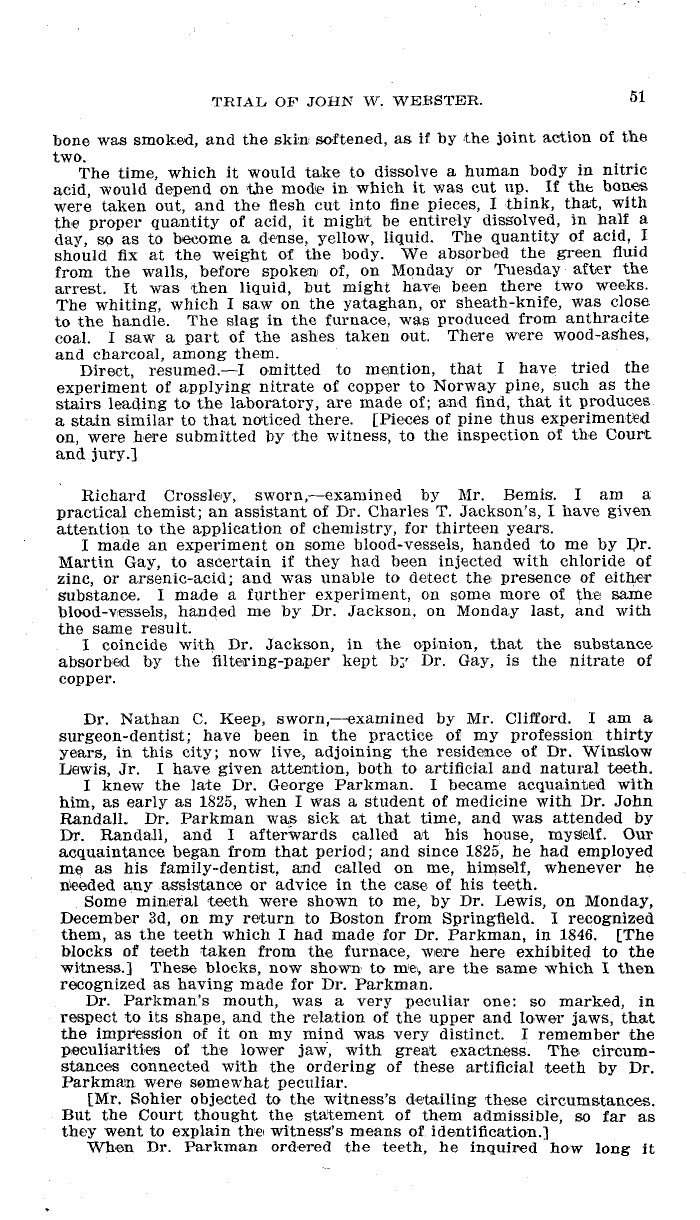|
TRIAL OF JOHN W. WEBSTER. 51
bone was smoked, and the skin softened, as if by the joint action of the
two.
The time, which it would take to dissolve a human body in nitric
acid, would depend on the mode in which it was cut up. If the bones
were taken out, and the flesh cut into fine pieces, I think, that, with
the proper quantity of acid, it might be entirely dissolved, in half a
day, so as to become a dense, yellow, liquid. The quantity of acid, I
should fix at the weight of the body. We absorbed the green fluid
from the walls, before spoken of, on Monday or Tuesday after the
arrest. It was then liquid, but might have, been there two weeks.
The whiting, which I saw on the yataghan, or sheath-knife, was close
to the handle. The slag in the furnace, was produced from anthracite
coal. I saw a part of the ashes taken out. There were wood-ashes,
and charcoal, among them.
Direct, resumed.-I omitted to mention, that I have tried the
experiment of applying nitrate of copper to Norway pine, such as the
stairs leading to the laboratory, are made of; and find, that it produces
a stain similar to that noticed there. [Pieces of pine thus experimented
on, were here submitted by the witness, to the inspection of the Court
and jury.]
Richard Crossley, sworn,-examined by Mr. Bemis. I am a
practical chemist; an assistant of Dr. Charles T. Jackson's, I have given
atteritian to the application of chemistry, for thirteen years.
I made an experiment on some blood-vessels, handed to me by Dr.
Martin Gay, to ascertain if they had been injected with chloride of
zinc, or arsenic-acid; and was unable to detect the presence of either
substance. I made a further experiment, on some more of the same
blood-vessels, handed me by Dr. Jackson, on Monday last, and with
the same result.
I coincide with Dr. Jackson, in the opinion, that the substance
absorbed by the filtering-paper kept b; Dr. Gay, is the nitrate of
copper.
Dr. Nathan C. Keep, sworn,-examined by Mr. Clifford. I am a
surgeon-dentist; have been in the practice of my profession thirty
years, in this city; now live, adjoining the residence of Dr. Window
Dewis, Jr. I have given attention, both to artificial and natural teeth.
I knew the late Dr. George Parkman. I became acquainted with
him, as early as 1825, when I was a student of medicine with Dr. John
Randall. Dr. Parkman was sick at that time, and was attended by
Dr. Randall, and I afterwards called at his house, my%~edf. Our
acquaintance began from that period; and since 1825, he had employed
me as his family-dentist, and called on me, himself, whenever he
needed any assistance or advice in the case of his teeth.
Some xnimemal teeth were shown to me, by Dr. Lewis, on Monday,
December 3d, on my return to Boston from Springfield. I recognized
them, as the teeth which I had made for Dr. Parkman, in 1846. [The
blocks of teeth taken from the furnace, were here exhibited to the
witness.] These blocks, now shown to me, are the same which I then
recognized as having made for Dr. Parkman.
Dr. Parkman's mouth, was a very peculiar one: so marked, in
respect to its shape, and the relation of the upper and lower jaws, that
the impression of it on my mind was very distinct. I remember the
Peculiarities of the lower jaw, with great exactness. The, circum-
stances connected with the ordering of these artificial teeth by Dr.
Parkman were somewhat peculiar.
[Mr. Sohier objected to the witness's detailing these circumstances.
But the Court thought the statement of them admissible, so far as
they went to explain they witness's means of identification.]
When Dr. Parkman ordered the teeth, he inquired how long it
|

